Abstract
In this new world of fluid technologies, hybrid nanofluid has become a productive subject of research among scientists for its potential thermal features and abilities, which provides an excellent result as compared to nanofluids in growing the rate of heat transport. Our purpose here is to introduce the substantial influences of magnetic field on 2D, time-dependent and stagnation point inviscid flow of couple stress hybrid nanofluid around a rotating sphere with base fluid is pure blood, as the nanoparticles. To translate the governing system of partial differential equations and the boundary conditions relevant for computation, some suitable transformations are implemented. To obtain the analytical estimations for the corresponding system of differential expression, the innovative Optimal Homotopy Analysis Method is used. The characteristics of hybrid nanofluid flow patterns, including temperature, velocity and concentration profiles are simulated and analyzed in detail due to the variation in the evolving variables. Detailed research is also performed to investigate the influences of relevant constraints on the rates, momentum and heat transport for both and . One of the many outcomes of this analysis, it is observed that increasing the magnetic factor will decelerate the hybrid nanofluid flow velocity and improve the temperature profile. It may also be demonstrated that by increasing the Brownian motion factor, significant improvement can be made in the concentration field of hybrid nanofluid. The increase in the nanoparticle volume fraction from 0.01 to 0.02 in the case of the hybrid nanofluid enhances the thermal conductivity from 5.8 to 11.947% and for the same value of the nanoparticle volume fraction in the case of nanofluid enhance the thermal conductivity from 2.576 to 5.197%.
Subject terms: Energy science and technology, Mathematics and computing, Nanoscience and technology, Physics
Introduction
In recent studies, bio-nanotechnology is one of the revolutionary approaches that unlock the new frontiers in the field of biological science, medicine and engineering industries. This development involves producing and studying tiny materials supposed to be 1 nm to 100 nm in dimension. The synthesis of nanomaterials and natural sciences aims to introduce different novel nano-devices that allow revolutionary phenomena and biomedical discoveries to be explored at the molecular level. Such advancements provide science with various techniques and instruments for clinical testing, medicinal and preventative healthcare applications. For that cause, an extension of certain nano-devices, nanomaterials, including their implementations in biotechnology, drugs, and engineering industries, is explored by many other investigators1–3. In 1904, Maxwell4 specifically initiated the theory of retaining micro-scale particles in coolants, so it did not gain significant interest due to any drawbacks. Anyway, the theory once again captured the interest of researchers following the invention of nanoparticles. Choi5 initially interpreted the expression Nanofluid. Sheikholeslami6 simply stated a nanofluid is just a liquid comprising tiny sized elements known as nanoparticles. In general, such nanoparticles are made of ceramic , metals , metal nitrides , Ferro particles , carbon in various forms (diamonds, graphite and carbon nanotubes) etc. Parvin and Chamkha7 documented the heat transport, convection fluid flow and entropy generation in longitudinal and transverse enclosure form. Cu/water nanofluid occupies the space. Specifically, the quantitative simulation explains the influence of the fluid flow factors on Bejan and Nusselt numbers. A comprehensive analysis of the Buongiorno nanofluid model for the solution of natural convectional flow in a partly warmed curly space fill utilizing nanofluid has been performed by Pop et al.8. In another investigation, Ghasemian et al.9 examined the Buongiorno model to analyze the 3D uncontrolled nanofluid movement through a square tube with a sinusoidal diameter. The concentration has been focused on scientific research, analysis involving the saturation of two or even more nanomaterials in common fluid, termed hybrid nanofluid/ compound fluid10.
Many scholars have made some important attempts to investigate these types of hybrid nanofluid flows and many reports are available that cast the light on the possible features of those sorts of frameworks. In specific, nanofluid is quite recognized as a high heat transport fluid. In this article, the hybrid nanofluid is discussed further to improve the conventional nanofluid's heat transport efficiency. Recently, various numerical studies were examined on hybrid nanofluids as a new idea in science and technology. Devi and Devi11 scrutinized the problems of heat transfer and flow of hydro-magnetic hybrid nanofluids through an extending surface. Tayebi and Chamkha12 computed numerically the problem of heat transport of hybrid nanofluids in an annulus. In another investigation, the characteristics of hybrid nanofluid with Lorentz force were scrutinized by Ghadikolaei et al.13. Hayat et al.14 inspected the rotating flow problem of hybrid nanofluids. The aqueous Titania-copper hybrid nanofluid stagnation point flow towards the stretching tube was explored by Yousefi et al.15. Subhani and Nadeem16 studied the behavior of (hybrid nanofluid) over the stretching surface. Dinarvand et al.17 introduced /blood (hybrid nanofluid) circulation on a permeable stretching sheet, which is an advanced density concept, that can be a favorable model in medical sciences, particularly in cancer therapy and drug delivery. In an investigation for cancer cell therapy, Liu et al.18 examined that and are the best nanocomposites. Through their laboratory analysis they found in the involvement of or nanoparticles, after two hours of treatment with UV irradiation the remaining fraction of cancer cell was diminished in both situations. In summary, this has been reported that most cancer cells will destroy using metal- nanocomposite particles than nanoparticles single which illustrates the need to use nano-materials in medicines. In combination with its special characteristics, (silver) has various biomedical uses, such as permeability, strength, electrochemical and anti-bacterial properties. For anti-bacterial activities against the slew of micro-organisms such as microbes, protozoa, fungi, even the latest viruses, and -related substances are used. Their contributions show the anti-tumor effect of particles which indicate that they could be a cost-effective cancer therapy then another treatment19. Some recent studies regarding hybrid nanofluids flows with different geometries are investigated by Zainal et al.20–22 and Dinarvand23–25.
In different engineering fields, the fluid flowing around hot rotating frames has many implementations, including gravitational chemical processing, advanced technology, spin-stabilized rocket temperature control, electric pumps and generators, thermal plasma manufacturing, and painting spray processes. Takhar and Nath26 have investigated the self-similar approach for passing flow at the stagnation point through a spinning sphere in the presence of magnetic force influences. In another work, Anilkumar and Roy27 scrutinized time-dependent variable viscosity movement in the zone of stagnation point a spinning sphere under which the free-stream momentum and angular speed of the revolving sphere very gradually with time. The variational magnetic, thermal convectional flow via a spinning cone in the transversely isotropic porous surface was investigated by Beg et al.28. Chamkha and Ahmad29 calculated the numerical result of time-dependent MHD free and mixed convectional motion and heat transport via a spinning sphere. More recently, Mahdy et al.30 introduced a mathematical model to determine the Casson fluid flow of due to rotating sphere in the presence of conjugate MHD, entropy generation and convective boundary conditions.
Although the base fluid is “pure blood” in our current model, it must be remembered that the blood viscidness is not really consistent from the medical perspective, and it will be changed not only through vessel diameter but also by temperature hematocrit factor and stress. In numerous investigations, this has been also specified that Newtonian blood performance's presumption is suitable for high shear rate motion, for instance, inflow across blood vessels. Usually, as the blood circulation improves, the blood thickness decreases, improving the speed of blood flow and reducing clotting factors31. The curved flexible artery through which the blood's viscosity is presumed to be temperature-dependent was studied by Akbar and Nadeem32. The statistical blood flow model with circular-based viscosity was examined by Gupta et al.33. Ijaz et al.34 analyzed the theoretical results of hemodynamics with unique features utilizing /blood, hybrid nanofluid flow in stenosized arteries. Ellahi et al.35 conducted a numerical investigation of the peristaltic flow of a couple stress-based gold nanofluid among the hole of dual co-axial cylinders with various outlines and structures. Chahregh and Dinarvand36 examined the circulation of /blood, hybrid nanofluid across a vessel for blood as well as drug transport applications in the respiration process.
Also, to the best of the authors' knowledge in the relevant literature, no one has ever tried to investigate the movement around a rotating sphere using pure blood as a based liquid and hybrid nano-materials to explain many real-life biomedical applications and medication filed and transportation. Supported by the said research findings, this article analyzes an appropriate framework of couple stress hybrid nanofluid movement of mixed convection across a spinning sphere in the immersion of MHD, thermophoresis and Brownian motion effect. The hybrid nanofluid is illustrated by maintaining two separate Titania and silver nanoparticles in the base fluid blood. The governing equations including constraints are transformed into a boundary value problem of differential equations based on the similarity transformation. Using the OHAM (Optimal Homotopy Analysis Method) in Mathematica, the system of equations is then explained analytically. Moreover, the consequences of several other variables' characteristics of flow and heat transport are seen numerically and graphically.
Mathematical formulation
In the stagnation point zone around a rotating sphere, we assume a time-dependent flow of mixed convection of the couple stress hybrid nanofluid /blood with the Buongiorno's mathematical model flow along with convective boundary conditions. Figure 1 demonstrates the working model and related coordinate structure of the problem. The model is totally based on the theoretical analysis and the experimental data in Table 3 is used from the existing literature reference36. The working problem is presented on some specific assumptions:
-
i.
The x-axis is determined on the surface of a sphere and the y-axis is normal to it.
-
ii.
The magnetic field is considered perpendicular to the flow field.
-
iii.
It is supposed that the temperature and concentration at the surface of the sphere have where the ambient temperature and concentration.
-
iv.
The viscus dissipation terms are negligible.
-
v.
Many mechanisms, including thermophoresis, Brownian motion and the MHD impacts are taken into consideration.
-
vi.
The nanoparticles are supposed to be in thermal equilibrium.
Figure 1.
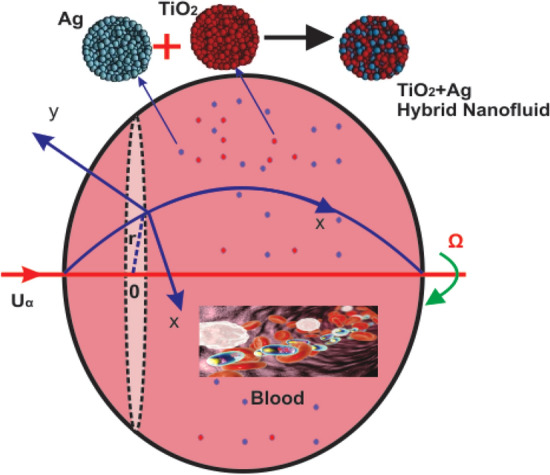
Configuration of model problem.
Table 3.
Various thermo-physical characters of blood, Silver and Titania36.
| Thermo-physical Prop. | Size (nm) | |||
|---|---|---|---|---|
| Silver: | 2–5 | 235 | 10,500 | 429 |
| Titania: (Titanium dioxide) | 50 | 686.2 | 4250 | 8.954 |
| Pure blood | – | 3594 | 1063 | 0.492 |
In view of such flow assumptions, the resulting equations interpreted as30,36:
| 1 |
| 2 |
| 3 |
| 4 |
| 5 |
In said expressions heat capacity ratio with is the blood heat capacity, is the solid nanoparticles heat capacity, are the diffusion coefficients of (Brownian, thermophoresis), is the magnetic field, is the gravitational acceleration, are velocities element in and directions, is the couple stress parameter, , , , and are viscosity, density, electrical and thermal conductivities and specific heat, where hybrid nanofluid refer . All such relations11 and defined in Tables 1 and 2.
Table 1.
| Viscosity | |
| Density | |
| Specific heat | |
| Thermal conductivity |
Table 2.
| Viscosity | |
| Density | |
| Specific heat | |
| Thermal conductivity |
Initially, as the first nanoparticle we scattered (Titania) into the blood (base fluid) to produce a (mono-nano liquid). In our current (base liquid), (Silver) is then dispersed as a supplementary nanoparticle to construct the appropriate (hybrid nanofluid). In this case, the subscript denotes (Titania nanoparticles), although subscript denotes to (Silver nanoparticles) and subscript mentions pure blood (base fluid). In Tables 1 and 2, and are refer the volume fraction of and nanoparticles, where refer normal fluid.
Initial and boundary conditions
Subject to the corresponding initial and boundary condition30
| 6 |
Similarity variables
To renovate above expressions which represent the flow problem to dimensionless system, we use the following similarity transformation30
| 7 |
Invoking the similarity factors in Eq. (7) in model Eqs. (1)–(5) with boundary condition Eq. (1) converted into the following form:
| 8 |
| 9 |
| 10 |
| 11 |
Initial and boundary conditions in Eq. (6) transform into the following form
| 12 |
Here the Schmidt number, Prandtl number, Reynolds number, Couple stress parameter, Biot number, Grashof number, Buoyancy ratio, Brownian motion and thermophoresis parameters, the rotation parameter, mixed convection parameter, and magnetic field parameter are
| 13 |
Skin friction and Nusselt number
| 14 |
Solution methodology
The newly introduced BVPh 2.0 package of OHAM37,38 has been used to find the solution of the nonlinear problem. This package has the tendency to obtain the outputs of the modeled problem in short time. The recent solution has been achieved using the above-mentioned package. The trail solution for the modeled problem is obtained as:
| 15 |
The square residual error for each one Eqs. (9–11) is obtained through:
| 16 |
| 17 |
| 18 |
| 19 |
| 20 |
The sum of the total residual errors has been attained from the velocity, temperature and concentration profiles.
Result and discussion
This portion of the current study is concentrated throughout the theoretical analysis of blood base hybrid nanofluid flow around a rotating sphere. From these analyses certain important insights are produced from the graphical configurations of the velocity, temperature, and concentration profile, taking into account various groundbreaking parameters. In the presence of distinct nanoparticles, the whole theoretical analysis is based on comparing /blood and /blood with the help of the stated problem. Through the aid of some fixed mathematical values of factors like (corresponds to /blood case) and (corresponds to /bloodcase), ,,,,, , these configuration patterns are performed. In the current analysis, two different types of nanoparticles /blood and /blood are considered and its detail of thermophysical features of /blood (nanofluid) and /blood (hybrid nanofluid) are presented in Tables 2 and 3. The thermal-physical characteristics of , and blood at 25 °C are specified in Table 3. The comparison of the published with the present work is displayed in Table 4. Similarly, Table 5 displays the variation of both for /blood (nanofluid) and /blood (hybrid nanofluid). Since are directly related to . As a consequence, it is dug out that the remarkable nature is investigated for /blood (nanofluid) and /blood. In addition, it was clear from Table 5 that in the case of /blood (hybrid nanofluid) demonstrated superiority when equated to the /blood (nanofluid). The results of the current analysis for the (heat transfer rate) are exposed in Table 6. It is worth mentioning that is directly related to the . So enhances due to the intensification of parameters. The percentage (%) enhancement in the heat transfer rate has been observed with the increment of the nanoparticle volume fractions . Increase in the from 0.01 to 0.02 in case of the enhance the thermal conductivity 5.8% and 11.947% respectively. Furthermore, the same value of the nanoparticle volume fraction in case of enhancing the thermal conductivity 2.576% and 5.197% respectively as shown in Table 6. Also, the convergence of OHAM-BVPh 2.0 package up to 25 orders of approximation is displayed in Tables 7 and 8 for /blood (nanofluid) and /blood (hybrid nanofluid) respectively. Detailed results of the model problem have been achieved and its corresponding specifications are graphically presented for component of and (primary and secondary velocities), temperature field and nanoparticle concentration filed in Figs. 2, 3, 4, 5, 6, 7, 8, 9, 10, 11, 12, 13, 14, 15, and 16. Figures 2, 3, 4, and 5, we have plotted to describe the physical behavior of and on primary velocities for variations in several variables present in the equation of motion. Such as and on flow is investigated graphically. Figure 2 depicts a particular image of the (primary velocity) profile for various values of (couple stress variable). It is predicted from the figure that (primary velocity) for both cases of fluid ( and ) declines as enhancing the value of . The explanation is so clear. By strengthening variable slow down the motion of both fluid ( and ) due to an increasing the drag force which is equal to an obvious reduction in the fluid viscosity. From such parabolic images, one should observe that the velocity of case gives frequent decline relative to the case of nanofluid. The influences of the first and the second nanoparticle volume fraction on the primary velocity field is graphically presented in Fig. 3. The primary velocity field is clearly seen to be remarkably declined against the enhancing value of the nanoparticle volume fraction and of fluids. Physically, the higher values of the nanoparticle volume fraction of and causes the thinning behavior of the momentum boundary layer. This should also be observed that the sharp decline in nanofluid velocity is lower than that for hybrids nanofluid . The effect of the (magnetic parameter) on the and primary velocities is investigated and the fundamental physics is visually illustrated in Fig. 4. Figure 4 indicates that when the (magnetic field) is raised, then the velocity field of and fluid sluggish. This declining influence on the velocity of the is more prominent than . Such decline state of velocities happens owing to the production of resistant type force identified as Lorentz force. The strength of such force enhances with the rising strength of which counteracts the motion of fluid in boundary film and drop the viscosity of boundary film. The effect of (mixed convection parameters) on and fluid of primary velocity is demonstrated in Fig. 5. In order to increase the (mixed convection parameters) the primary velocity is significantly accelerated. A velocity enhancing is reported, through a greater magnitude of the which could be due to the high buoyancy force. The supporting buoyancy force works as a desirable pressure gradient and significantly speeds up . This accelerating influence on of the /blood is more prominent than that of the nanofluid. Figures 6, 7, and 8, we have plotted to describe the physical behavior of and /blood on the secondary velocity field for variations in several of model equations. The physical nature of these model factors and on flow is graphically studied. The influence of the (magnetic field) on the both ( and /blood) nanofluid secondary velocities is also examined and the essential physics is visually demonstrating in Fig. 6. Figure 6 specifies that when the magnitude of is more elevated than the velocity field of and fluid slow down. Such diminishing effect on the of the is much more prominent than the . Such decay condition of velocities happen due to the creation of protected type force identified as Lorentz force. The power of such force improves with the growing strength of which offsets the speed of both fluids within boundary layer and drop the thickness of the boundary layer. The vs first and second nanoparticle volume fraction behaviors are seen in Fig. 7, that indicates that of both ( and /blood) decreases as the increases. Substantially, the higher values of both of nanofluid and hybrid nanofluid cause the thinning behavior of the momentum boundary layer. This should also be observed that the sharp decline in nanofluid velocity is lower than that for hybrids nanofluid . The effect of the (rotation parameter) of and fluid on secondary velocity components is seen in Fig. 8. In order to upsurge the magnitude of , the secondary velocity components are significantly accelerated. It is clear from the diagram that the rotation becomes much more intense by increasing the λ, and the secondary momentum helps more through the swirl effect that retards the secondary movement . From this parabolic plot, one should perceive that the velocity of case gives frequent increase relative to the case of nanofluid. The Figs. 9, 10, 11, 12, and 13, afterward demonstrating the effect of and on for both ( and /blood). To scrutinize the trend of on , Fig. 9 is plotted for both cases of ( and /blood). It is evident from the plot that the field shows the diminishing role for . Consequently, it is defensible owing to the basic reason that thermal conductivity of the fluid relative lesser with an intensified magnitude of and thus reducing the temperature of both ( and /blood). It's also reported herein that in the scenario of the temperature field reached its maximum value as compared to the nanofluid case. The variance in (magnetic parameter) on temperature profile is depicted in Fig. 10 for both ( and /blood). Form this drawing it is detected that and thermal layer thickness enhances via growing magnitude of magnetic parameter . The magnetic parameter and density of ( and /blood) are inversely related with each other. Hence, the strengthening value of shrinking the density and as a consequence the thermal nature of fluid upsurges. From this outline, one can observe that the temperature for case tends to decrease more quickly relative to the case of . The effect of the (unsteadiness parameter) on both ( and /blood), temperature profiles is revealed in Fig. 11. This can be seen from a plot that are rising the magnitude of leads to a reduction in the temperature field. Physically, with increasing values of , the field is reduced, indicating that the thermal boundary surfaces are diminished with the growing magnitude of . Therefore, the boundary layer is cooler, so additional temperature and nanoparticles are moved to the surface of the sphere (wall) with a growing magnitude of . It's also described herein that in the scenario of the temperature field reached its maximum value as compared to the nanofluid case. The effect of on is also studied and the basic reason is obviously portrayed in Fig. 12. From the drawing it is observed that the is enhanced for the increase in the volume concentration of both nanoparticles and hybrid , which can be attributed to the collisions between the suspended nanoparticles. is basically link to both nanoparticles, therefore, the effect of both nanoparticles on is observed. Mostly, the stimulation of thermal boundary film viscosity to is linked to upgraded thermal conduction of both ( and ). In fact, superior amount of thermal conduction is reinforced by improved thermal diffusivity. Actually, field is directly related to both in case of contraction and in this scenario, it displays extra inconsistency closed to the wall of the sphere. Due to evolving (thermophoresis parameter), this paragraph is dedicated to capturing the variation in the temperature profile for both nanoparticles and hybrid . Figure 11 is depicted in order to observe the way that temperature is affected. Figure 13 illustrates that the magnitude of both ( and ) temperature grows by enhancing . Basically, it is how the thermophoresis force allows the particles to shift from the hot zone to the cold area, improves as raises and the thermophoresis force improves which upgrades the magnitude of temperature field magnitude of nanofluids and hybrid nanofluids . Figures 14, 15, and 16, we have designed to define the physical characteristics of and /blood on concentration profile for variations in several variable present in the model equations. Such as and on concentration profile is investigated graphically. The consequence of the (Schmidt Number) on (concentration) profiles is portrayed in Fig. 14 for the case of ( and ). The magnitude is reduced slightly substantially with rising values of . Basically, the relation of momentum diffusivity to mass (nanoparticle) diffusivity is called . For , diffusivity in mass dominates diffusivity in momentum, and vice versa for . Hence, with higher , concentration boundary-layer density for both nanoparticles is substantially enhanced, while the thermal boundary-layer density is marginally reduced. In order to see the influence of volumetric fractions of nanomaterials on the concentration profile , Fig. 15 has been plotted for both ( and /blood). It is noticeable that the decline in solute concentration was perceived by growing the volumetric fraction of nano additives . In addition, lower values for /blood, hybrid nanofluid were observed in the profile when equated to nanofluid. The effect of the concentration profile of the (Brownian motion parameter) is displayed in Fig. 16 for the case of ( and /blood). An improvement to lead to accelerates as seen in Figure. Physically, it is attributable to disperse through the () particles, fluid improvements with the maximization of . It is therefore understood that in the case of /blood, hybrid nanofluid, as can be seen in the figure the temperature gets its highest values as compared with nanofluid.
Table 4.
Comparison between the present results and Ref for the velocity gradient at different values of for .
Table 5.
Evaluation of the Skin friction coefficients for selected values of .
| 0.1 | 0.1 | 0.01 | 2.32541 | 2.12971 | 1.3469128 | 1.335724 |
| 0.3 | 2.32750 | 2.14382 | 1.3478239 | 1.336736 | ||
| 0.5 | 2.37110 | 2.16261 | 1.3488348 | 1.337748 | ||
| 0.1 | 0.2 | 2.87276 | 2.59942 | 1.3484724 | 1.339258 | |
| 0.3 | 2.89991 | 2.63724 | 1.3585232 | 1.341457 | ||
| 0.1 | 0.1 | 0.00 | 2.33763 | 2.11645 | 1.3458017 | 1.342372 |
| 0.02 | 3.48962 | 3.27468 | 1.3512781 | 1.351278 | ||
| 0.04 | 3.65905 | 3.38579 | 1.3573238 | 1.357323 |
Table 6.
Evaluation of the heat transfer rate for selected values of using the % formula .
| 1 | 0.1 | 0.01 | 0.05123 | 0.037077 |
| 1.5 | 0.1 | 0.05934 | 0.037823 | |
| 2 | 0.1 | 0.06745 | 0.038039 | |
| 2 | 0.2 | 0.06956 | 0.038564 | |
| 2 | 0.3 | 0.07376 | 0.038917 | |
| 2 | 0.4 | 0.07959 | 0.039021 | |
| 2 | 0.4 | 0.09502 | 0.039346 | |
| 0.0 | 0.0424654 | 0.0492 | ||
| 0.01 | 0.0449406 (5.8% Increase) | 0.0504676 (2.576% Increase) | ||
| 0.02 | 0.0475391 (11.947% Increase) | 0.0517571 (5.197% Increase) |
Table 7.
Convergence of OHAM for .
| 5 | ||
| 10 | ||
| 15 | ||
| 20 | ||
| 25 |
Table 8.
Convergence of OHAM for .
| 5 | ||
| 10 | ||
| 15 | ||
| 20 | ||
| 25 |
Figure 2.
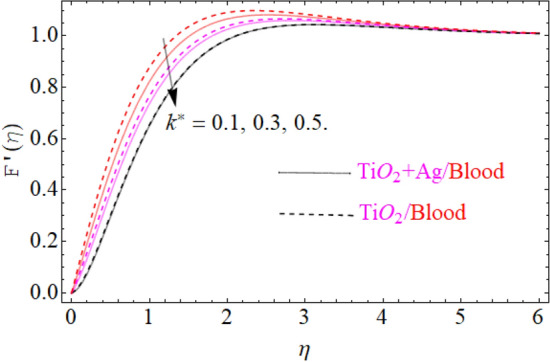
Under the influence of (couple stress parameter), .
Figure 3.

Under the influence of (Nanoparticle volume fraction), .
Figure 4.
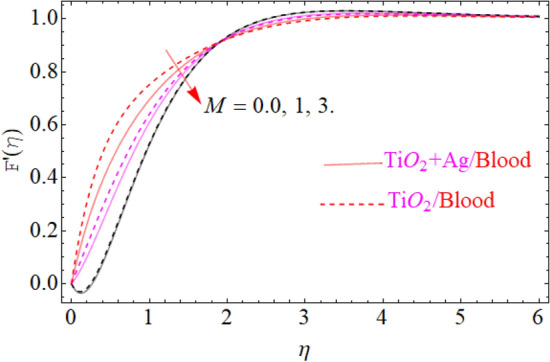
Under the influence of (Magnetic field parameter), .
Figure 5.
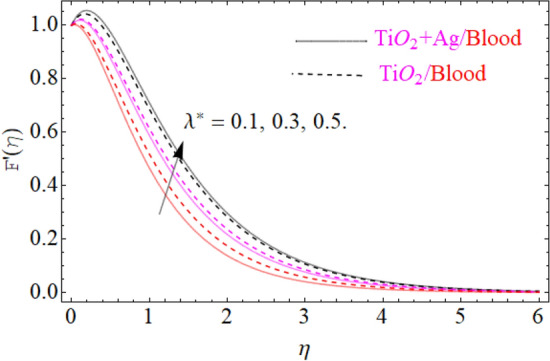
Under the influence of (mixed convection parameter), .
Figure 6.
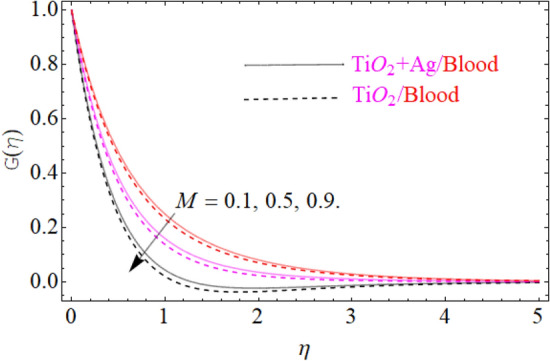
Under the influence of (Magnetic parameter), .
Figure 7.
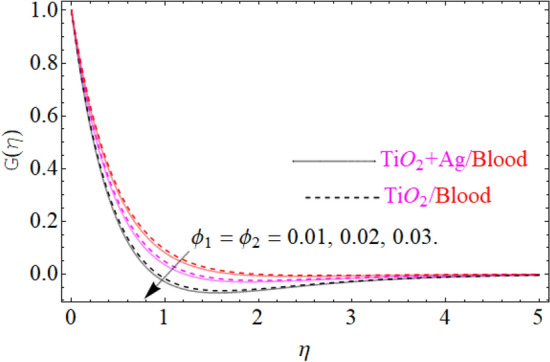
Under the influence of (nanoparticle volume friction), .
Figure 8.
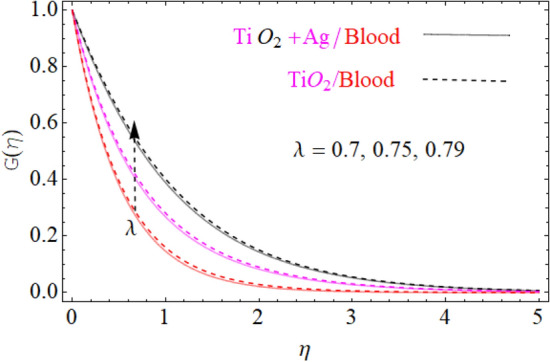
Under the influence of (rotation parameter), .
Figure 9.
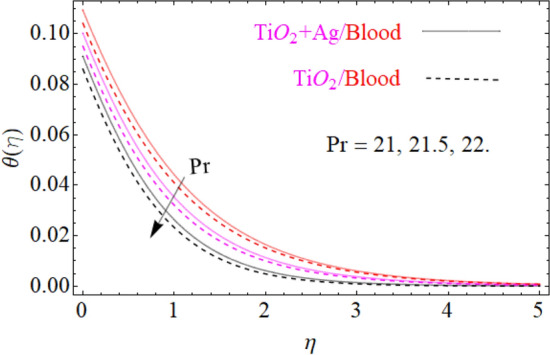
Under the influence of (Prandtl number), .
Figure 10.
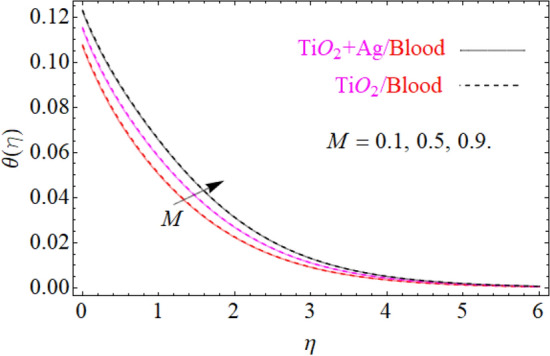
Under the influence of (Magnetic parameter), .
Figure 11.

Under the influence of (unsteadiness parameter), .
Figure 12.
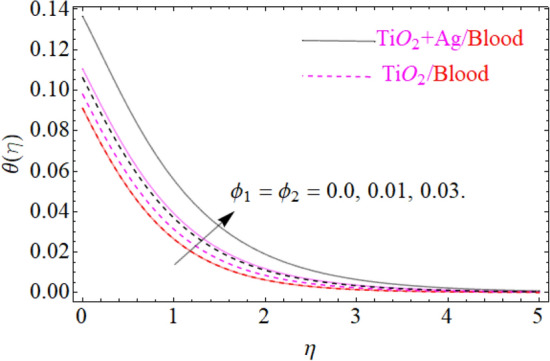
Under the influence of (nanoparticle concentration parameter), .
Figure 13.
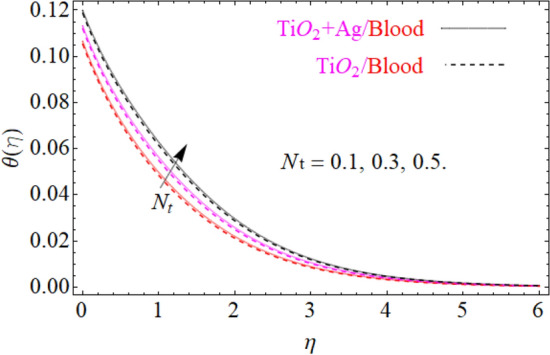
Under the influence of (thermophoresis parameter), .
Figure 14.
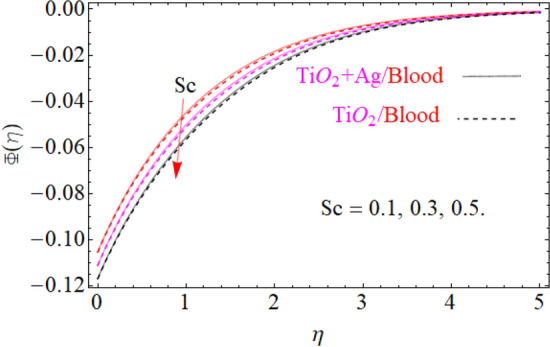
Under the influence of (Schmidt number), .
Figure 15.
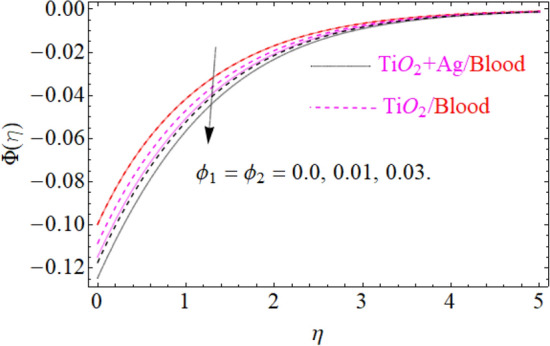
Under the influence of (nanoparticle concentration parameter), .
Figure 16.
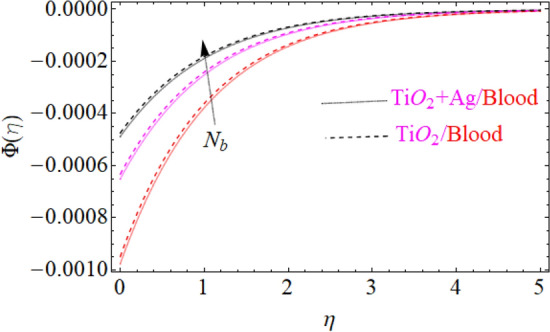
Under the influence of (Brownian motion parameter), .
Concluding remarks
The circulation of the /blood, hybrid nanofluid was examined around a rotating sphere under the action of a uniform applied magnetic field. The velocity, temperature along with concentration distribution, was also scientifically and systematically analyzed by taking the effects of , and into consideration. The main results of this analysis were the following:
The component of primary velocity, declined with the boosting value of and , while an accelerating behavior was perceived via enhancing value of .
Also, the secondary velocity component, boosted with the enhancing value of , where declinatory conduct was found through increasing values of and .
In contrast to nanofluid, the /blood (hybrid nanofluid) demonstrated a weak velocity profile of and .
For the growing values of and , temperature elevation was chronicled. In those scenarios, the /blood (hybrid nanofluid) exhibited the greatest temperature as equated to nanofluid.
With the increasing value of , an increase in the was observed. However, an opposite pattern was reported in increasing .
demonstrated considerable superiority in the case of /blood (hybrid nanofluid) as equated to nanofluid.
There was considerable realistic relevance to the current study, particularly in the field of biomedical and chemical industries.
The output shows that the increase in the from 0.01 to 0.02 in case of the enhance the thermal conductivity 5.8% and 11.947% and for the same value of the nanoparticle volume fraction in case of enhancing the thermal conductivity 2.576% and 5.197%.
Acknowledgements
The authors acknowledge the financial support provided by the Center of Excellence in Theoretical and Computational Science (TaCS-CoE), KMUTT. Moreover, this research project is supported by Thailand Science Research and Innovation (TSRI) Basic Research Fund: Fiscal year 2021 under Project number 64A306000005.
List of symbols
- ,
Velocities components
Magnetic field strength
Dimensional velocity profiles
Fluid temperature
Surface temperature
Free surface temperature
Surface concentration
Magnetic parameter
Coefficients of Brownian movement
Diffusion coefficients of thermophoresis
Prandtl number
Local Reynolds number
Eckert number
Grashof number
Nusselt number
Skin friction coefficient
Couple stress parameter
Biot number
Specific heat of base fluid
Thermal conductivity
Greek symbols
Dynamic viscosity of nanofluid
Dynamic viscosity of base fluid
Nanofluid density
Base fluid density
Similarity variable
- and
Volume fraction of and nanoparticles
Dimensional concentration profile
Dimensional heat profile
Electrical conductivity of nanofluid
Rotation parameter
Mixed convection parameter
The total residual error
Subscripts
- nf
Nanofluid
- f
Base fluid
- hnf
Hybrid nanofluid
Abbreviations
- OHAM
Optimal homotopy analysis method
- MHD
Magneto-hydrodynamics
- CNTs
Carbon nanotubes
Author contributions
T.G., B.A. and S.N. modeled and solved the problem. M.J. and A.S. wrote the manuscript. W.A and S.M., T.G. and A.T. contributed in the numerical computations and plotting the graphical results. W.A and S.M., P.K., A.S. and T.G. work in the revision of the manuscript. All the corresponding authors finalized the manuscript after its internal evaluation.
Data availability
The data that support the findings of this study are available from the corresponding author upon reasonable request.
Competing interests
The authors declare no competing interests.
Footnotes
Publisher's note
Springer Nature remains neutral with regard to jurisdictional claims in published maps and institutional affiliations.
References
- 1.Bhatti MM, Zeeshan A, Ellahi R. Endoscope analysis on peristaltic blood flow of Sisko fluid with titanium magneto-nanoparticles. Comput. Biol. Med. 2016;78:29–41. doi: 10.1016/j.compbiomed.2016.09.007. [DOI] [PubMed] [Google Scholar]
- 2.Ijaz S, Nadeem S. A biomedical solicitation examination of nanoparticles as drug agent to minimize the hemodynamics of stenotic channel. Eur. Phys. J. Plus. 2017;132:448. doi: 10.1140/epjp/i2017-11703-6. [DOI] [Google Scholar]
- 3.Kamyar A, Saidur R, Hasanuzzaman M. Application of computational fluid dynamics (CFD) for nanofluids. Int. J. Heat Mass Transf. 2012;55(15–16):4104–4115. doi: 10.1016/j.ijheatmasstransfer.2012.03.052. [DOI] [Google Scholar]
- 4.Maxwell JC. Electricity and Magnetism. 3. Dover; 1904. [Google Scholar]
- 5.Choi SU, Eastman JA. Enhancing Thermal Conductivity of Fluids with Nanoparticles (No. ANL/MSD/CP-84938, CONF-951135-29) Argonne National Lab; 1995. [Google Scholar]
- 6.Sheikholeslami M, Öztop HF, Abu-Hamdeh N, Li Z. Nanoparticle transportation of CuO-H2O nanofluid in a porous semi annulus due to lorentz forces. Int. J. Numer. Methods Heat Fluid Flow. 2019;29(1):294–308. doi: 10.1108/HFF-01-2018-0014. [DOI] [Google Scholar]
- 7.Parvin S, Chamkha AJ. An analysis on free convection flow, heat transfer and entropy generation in an odd-shaped cavity filled with nanofluid. Int. Commun. Heat Mass Transf. 2014;54:8–17. doi: 10.1016/j.icheatmasstransfer.2014.02.031. [DOI] [Google Scholar]
- 8.Pop I, Sheremet M, Cimpean DS. Natural convection in a partially heated wavy cavity filled with a nanofluid using Buongiorno’s nanofluid model. Int. J. Numer. Methods Heat Fluid Flow. 2017;27(4):924–940. doi: 10.1108/HFF-12-2015-0529. [DOI] [Google Scholar]
- 9.Ghasemian A, Dinarvand S, Adamian A, Sheremet MA. Unsteady general three-dimensional stagnation point flow of a maxwell/Buongiorno non-Newtonian nanofluid. J. Nanofluids. 2019;8(7):1544–1559. doi: 10.1166/jon.2019.1701. [DOI] [Google Scholar]
- 10.Ijaz S, Nadeem S. Biomedical theoretical investigation of blood mediated nanoparticles (Ag-Al2O3/blood) impact on hemodynamics of overlapped stenotic artery. J. Mol. Liq. 2017;248:809–821. doi: 10.1016/j.molliq.2017.10.112. [DOI] [Google Scholar]
- 11.Devi SA, Devi SSU. Numerical investigation of hydromagnetic hybrid Cu–Al2O3/water nanofluid flow over a permeable stretching sheet with suction. Int. J. Nonlinear Sci. Numer. Simul. 2016;17(5):249–257. doi: 10.1515/ijnsns-2016-0037. [DOI] [Google Scholar]
- 12.Tayebi T, Chamkha AJ. Free convection enhancement in an annulus between horizontal confocal elliptical cylinders using hybrid nanofluids. Numer. Heat Transf., Part A: Appl. 2016;70(10):1141–1156. doi: 10.1080/10407782.2016.1230423. [DOI] [Google Scholar]
- 13.Ghadikolaei SS, Yassari M, Sadeghi H, Hosseinzadeh K, Ganji DD. Investigation on thermophysical properties of Tio2–Cu/H2O hybrid nanofluid transport dependent on shape factor in MHD stagnation point flow. Powder Technol. 2017;322:428–438. doi: 10.1016/j.powtec.2017.09.006. [DOI] [Google Scholar]
- 14.Hayat T, Nadeem S, Khan AU. Rotating flow of Ag-CuO/H2O hybrid nanofluid with radiation and partial slip boundary effects. Eur. Phys. J. E. 2018;41(6):75–87. doi: 10.1140/epje/i2018-11682-y. [DOI] [PubMed] [Google Scholar]
- 15.Yousefi M, Dinarvand S, Yazdi ME, Pop I. Stagnation-point flow of an aqueous titania-copper hybrid nanofluid toward a wavy cylinder. Int. J. Numer. Methods Heat Fluid Flow. 2018;28(7):1716–1735. doi: 10.1108/HFF-01-2018-0009. [DOI] [Google Scholar]
- 16.Subhani M, Nadeem S. Numerical analysis of micropolar hybrid nanofluid. Appl. Nano-Sci. 2019;9(4):447–459. doi: 10.1007/s13204-018-0926-2. [DOI] [Google Scholar]
- 17.Dinarvand S, Nademi Rostami M, Dinarvand R, Pop I. Improvement of drug delivery micro-circulatory system with a novel pattern of CuO-Cu/blood hybrid nanofluid flow towards a porous stretching sheet. Int. J. Numer. Methods Heat Fluid Flow. 2019;29(11):4408–4429. doi: 10.1108/HFF-01-2019-0083. [DOI] [Google Scholar]
- 18.Liu L, Miao P, Xu Y, Tian Z, Zou Z, Li G. Study of Pt/TiO2 nanocomposite for cancer cell treatment. J. Photochem. Photobiol. B: Biol. 2010;98(3):207–210. doi: 10.1016/j.jphotobiol.2010.01.005. [DOI] [PubMed] [Google Scholar]
- 19.Sriram MI, Kanth SB, Kalishwaralal K, Gurunathan S. Antitumor activity of silver nanoparticles in dalton’s lymphoma ascites tumor model. Int. J. Nanomed. 2010;5:753–762. doi: 10.2147/IJN.S11727. [DOI] [PMC free article] [PubMed] [Google Scholar]
- 20.Zainal NA, Nazar R, Naganthran K, Pop I. MHD flow and heat transfer of hybrid nanofluid over a permeable moving surface in the presence of thermal radiation. Int. J. Numer. Methods Heat Fluid Flow. 2020;31:1–18. doi: 10.1108/HFF-03-2020-0126. [DOI] [Google Scholar]
- 21.Zainal NA, Nazar R, Naganthran K, Pop I. Impact of anisotropic slip on the stagnation-point flow past a stretching/shrinking surface of the Al2O3-Cu/H2O hybrid nanofluid. Appl. Math. Mech. 2020;41(9):1401–1416. doi: 10.1007/s10483-020-2642-6. [DOI] [Google Scholar]
- 22.Zainal NA, Nazar R, Naganthran K, Pop I. Unsteady stagnation point flow of hybrid nanofluid past a convectively heated stretching/shrinking sheet with velocity slip. Mathematics. 2020;8(10):1649. doi: 10.3390/math8101649. [DOI] [Google Scholar]
- 23.Dinarvand S, Rostami MN, Pop I. A novel hybridity model for TiO 2-CuO/water hybrid nanofluid flow over a static/moving wedge or corner. Sci. Rep. 2019;9(1):1–11. doi: 10.1038/s41598-019-52720-6. [DOI] [PMC free article] [PubMed] [Google Scholar]
- 24.Dinarvand S. Nodal/saddle stagnation-point boundary layer flow of CuO–Ag/water hybrid nanofluid: a novel hybridity model. Microsyst. Technol. 2019;25(7):2609–2623. doi: 10.1007/s00542-019-04332-3. [DOI] [Google Scholar]
- 25.Dinarvand S, Rostami MN. Three-dimensional squeezed flow of aqueous magnetite–graphene oxide hybrid nanofluid: a novel hybridity model with analysis of shape factor effects. Proc. Inst. Mech. Eng., Part E: J. Process Mech. Eng. 2020;234(2):193–205. doi: 10.1177/0954408920906274. [DOI] [Google Scholar]
- 26.Takhar HS, Nath G. Self-similar solution of the unsteady flow in the stagnation point region of a rotating sphere with a magnetic field. Heat Mass Transf. 2000;36(2):89–96. doi: 10.1007/s002310050369. [DOI] [Google Scholar]
- 27.Anilkumar D, Roy S. Self-similar solution of the unsteady mixed convection flow in the stagnation point region of a rotating sphere. Heat Mass Transf. 2004;40(6–7):487–493. [Google Scholar]
- 28.Bég OA, Prasad VR, Vasu B, Gorla RSR. Computational modeling of magnetohydrodynamic convection from a rotating cone in orthotropic Darcian porous media. J. Braz. Soc. Mech. Sci. Eng. 2017;39(6):2035–2054. doi: 10.1007/s40430-017-0708-x. [DOI] [Google Scholar]
- 29.Chamkha AJ, Ahmed SE. Unsteady MHD heat and mass transfer by mixed convection flow in the forward stagnation region of a rotating sphere at different wall conditions. Chem. Eng. Commun. 2012;199(1):122–141. doi: 10.1080/00986445.2011.575907. [DOI] [Google Scholar]
- 30.Mahdy A, Chamkha AJ, Nabwey HA. Entropy analysis and unsteady MHD mixed convection stagnation-point flow of Casson nanofluid around a rotating sphere. Alex. Eng. J. 2020 doi: 10.1016/j.aej.2020.04.028. [DOI] [Google Scholar]
- 31.Cinar, Y. & Kosku, N. Hypothesis: temperature stress and blood viscosity affects the leukocyte flexibility, coagulation, intracranial hypertension, and hemodynamics, 3. In International Conference on Life Science and Technology 120–126 (IACSIT Press, 2011).
- 32.Akbar NS, Nadeem S. Simulation of variable viscosity and Jeffrey fluid model for blood flow through a tapered artery with a stenosis. Commun. Theor. Phys. 2012;57:133–140. doi: 10.1088/0253-6102/57/1/20. [DOI] [Google Scholar]
- 33.Gupta S, Gupta M, Singh SP. Effect of radial viscosity variation on non- Newtonian flow of blood in a stenosed artery. Int. J. Appl. Math. Mech. 2012;8:51–61. [Google Scholar]
- 34.Ijaz S, Iqbal Z, Maraj EN, Nadeem S. Investigation of Cu-CuO/blood mediated transportation in stenosed artery with unique features for theoretical outcomes of hemodynamics. J. Mol. Liq. 2018;254:421–432. doi: 10.1016/j.molliq.2018.01.098. [DOI] [Google Scholar]
- 35.Ellahi R, Zeeshan A, Hussain F, Asadollahi A. Peristaltic blood flow of couple stress fluid suspended with nanoparticles under the influence of chemical reaction and activation energy. Symmetry. 2019;11(2):1–17. doi: 10.3390/sym11020276. [DOI] [Google Scholar]
- 36.Chahregh HS, Dinarvand S. TiO2-Ag/blood hybrid nanofluid flow through an artery with applications of drug delivery and blood circulation in the respiratory system. Int. J. Numer. Methods Heat Fluid Flow. 2020 doi: 10.1108/HFF-10-2019-0732. [DOI] [Google Scholar]
- 37.Liao SJ. An optimal homotopy-analysis approach for strongly nonlinear differential equations. Commun. Nonlinear Sci. Numer. Simul. 2010;15:2003–2016. doi: 10.1016/j.cnsns.2009.09.002. [DOI] [Google Scholar]
- 38.Gul T, Kiran F. The experimental study to examine the stable dispersion of the graphene nanoparticles and to look at the GO–H2O nanofluid flow between two rotating disks. Appl. Nanosci. 2018;8:1711–1727. doi: 10.1007/s13204-018-0851-4. [DOI] [Google Scholar]
Associated Data
This section collects any data citations, data availability statements, or supplementary materials included in this article.
Data Availability Statement
The data that support the findings of this study are available from the corresponding author upon reasonable request.


